- Joined
- Oct 9, 2007
- Messages
- 47,599 (7.45/day)
- Location
- Dublin, Ireland
| System Name | RBMK-1000 |
|---|---|
| Processor | AMD Ryzen 7 5700G |
| Motherboard | Gigabyte B550 AORUS Elite V2 |
| Cooling | DeepCool Gammax L240 V2 |
| Memory | 2x 16GB DDR4-3200 |
| Video Card(s) | Galax RTX 4070 Ti EX |
| Storage | Samsung 990 1TB |
| Display(s) | BenQ 1440p 60 Hz 27-inch |
| Case | Corsair Carbide 100R |
| Audio Device(s) | ASUS SupremeFX S1220A |
| Power Supply | Cooler Master MWE Gold 650W |
| Mouse | ASUS ROG Strix Impact |
| Keyboard | Gamdias Hermes E2 |
| Software | Windows 11 Pro |
Today, Intel made its newest piece of silicon, the Core i7 series processor official with the introduction of three models based on the newer architecture, and socket. One of the significant feature-additions for Core i7 is the 192-bit wide DDR3 memory bus, meaning that memory modules in groups of three or six can be used to make use of the triple-channel memory controller the processors come with.
For memory vendors, it means selling kits consisting of three or six modules of 1 GB or 2 GB per module, resulting in 3 GB, 6 GB or potentially, a 12 GB kit (consisting of six 2 GB modules). Corsair, on its part, has been advertising the benefits of 4 GB system memory in the recent past, in a bit to sell its 2x 2GB kits. One of the important benefits Corsair noted was, that it benefited today's games. Come Core i7, and Corsair thinks 6 GB of memory would significantly benefit gaming PCs based on the Core i7 processors. The company released a whitepaper, in which gaming performance between Core i7-based systems equipped with 3 GB and 6 GB of memory were compared.
The testbed consisted of a Core i7 965 Extreme Edition running on a ASUS P6T Deluxe, two GeForce GTX 280 cards in SLI, the software running on Windows Vista Ultimate SP1 64-bit, along with Forceware 180.43 beta drivers for the graphics. There were significant increments in the FPS for the in-game benchmark tool of World in Conflict. 6 GB of memory helped Crysis Warhead only by stepping up its minimum FPS a little overall, while providing a 200% boost in minimum FPS for its All the Fury test.
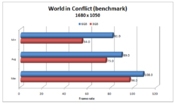
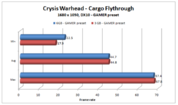
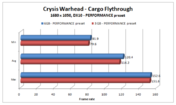
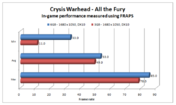
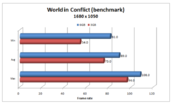
With today's games there's always the issue of higher amount of memory benefiting loading times, and the tests didn't deviate from the hypothesis. To show the how demanding today's games have become, there's a chart provided to show the memory load of the games tested. Most range above 2.2 GB, which given the fact that Windows Vista is the OS, would seem infufficient with the OS and its processes among other common processes today's PCs use. Also provided is a consolidated list of games showing to what extant 6 GB of memory helped step-up minimum frame-rate.
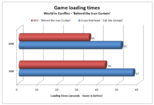
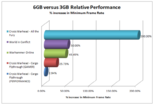
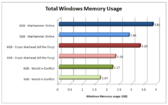
Without doubt this is Corsair pushing forth the idea of having 6 GB of memory, which may seem high in today's context, but gives you a little idea as to what to expect from having that amount of memory, where performance is critical (for benchmark junkies and the likes).
View at TechPowerUp Main Site
For memory vendors, it means selling kits consisting of three or six modules of 1 GB or 2 GB per module, resulting in 3 GB, 6 GB or potentially, a 12 GB kit (consisting of six 2 GB modules). Corsair, on its part, has been advertising the benefits of 4 GB system memory in the recent past, in a bit to sell its 2x 2GB kits. One of the important benefits Corsair noted was, that it benefited today's games. Come Core i7, and Corsair thinks 6 GB of memory would significantly benefit gaming PCs based on the Core i7 processors. The company released a whitepaper, in which gaming performance between Core i7-based systems equipped with 3 GB and 6 GB of memory were compared.
The testbed consisted of a Core i7 965 Extreme Edition running on a ASUS P6T Deluxe, two GeForce GTX 280 cards in SLI, the software running on Windows Vista Ultimate SP1 64-bit, along with Forceware 180.43 beta drivers for the graphics. There were significant increments in the FPS for the in-game benchmark tool of World in Conflict. 6 GB of memory helped Crysis Warhead only by stepping up its minimum FPS a little overall, while providing a 200% boost in minimum FPS for its All the Fury test.





With today's games there's always the issue of higher amount of memory benefiting loading times, and the tests didn't deviate from the hypothesis. To show the how demanding today's games have become, there's a chart provided to show the memory load of the games tested. Most range above 2.2 GB, which given the fact that Windows Vista is the OS, would seem infufficient with the OS and its processes among other common processes today's PCs use. Also provided is a consolidated list of games showing to what extant 6 GB of memory helped step-up minimum frame-rate.



Without doubt this is Corsair pushing forth the idea of having 6 GB of memory, which may seem high in today's context, but gives you a little idea as to what to expect from having that amount of memory, where performance is critical (for benchmark junkies and the likes).
View at TechPowerUp Main Site
Last edited:


 )
)


